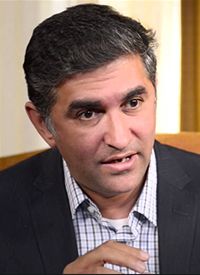Lifirafenib Active in Melanoma, Other Solid Tumors
The investigational RAF inhibitor lifirafenib demonstrated antitumor activity in patients with melanoma and other solid tumors.
Jayesh Desai, MD

Jayesh Desai, MD
The investigational RAF inhibitor lifirafenib (BGB-283) demonstrated antitumor activity in patients with melanoma and other solid tumors, according to findings from a phase I dose-escalation/expansion trial published in the Journal of Clinical Oncology.
Treatment with lifirafenib led to an objective response rate of 17% in patients with B-RAF mutations, including 1 complete response (CR) and 5 partial responses (PRs) in patients with melanoma. There were also 2 responses in patients with K-RAS—mutated tumors. Among patients with K-RAS/N-RAS—mutated colorectal cancer (CRC), there were no responses.
“Lifirafenib demonstrated an acceptable risk—benefit profile given the safety results and responses,” wrote first author Jayesh Desai, MBBS, Peter MacCallum Cancer Centre, Australia, and coauthors.
“Our findings suggest that lifirafenib could potentially benefit patients with MAPK pathway—associated kinase alterations beyond B-RAFV600 mutations, including activated K-RAS. Additional investigation of the safety/efficacy of lifirafenib as monotherapy or in combination is warranted, especially in K-RAS—mutated solid tumor malignancies other than CRC,” added Desai et al.
Lifirafenib is a novel inhibitor of key RAF family kinases and EGFR. The first-in-human, phase I, dose-escalation/dose-expansion study evaluated the safety, tolerability, and efficacy of lifirafenib in patients with B-RAF— or K-RAS/N-RAS—mutated solid tumors.
The dose-escalation phase included 35 patients with solid tumors including CRC (n = 13), non—small cell lung cancer (NSCLC; n = 9), melanoma (n = 5), cholangiocarcinoma (n = 2), thyroid (n = 3), endometrial (n = 2), and ovarian (n = 1).
The median age in the dose-escalation cohort was 59 years (range, 33-37), 62.9% were male, 34.3% had an ECOG performance status (PS) of 0, and 65.7% had an ECOG PS of 1. Almost all patients (88.6%) in the cohort had stage IV tumors. Regarding mutation status, 31.4% had B-RAF mutations, 57.1% had K-RAS mutations, and 11.4% had N-RAS mutations. Over half (51.4%) of patients had received ≥3 prior lines of therapy. No patients had received a prior B-RAF inhibitor.
The dose-escalation subgroups received treatment at 5, 10, 20, 30, 40, 50, and 60 mg of lifirafenib once daily. The maximum-tolerated dose was 40 mg daily, and the recommended phase II dose was 30 mg daily.
The dose-expansion phase included 96 patients with solid tumors including CRC (n = 34), NSCLC (n = 10), melanoma (n = 18), thyroid (n = 3), endometrial (n = 5), ovarian (n = 1), pancreatic (n = 18), and other tumor types (n = 7).
The median age in the dose-escalation cohort was 63 years (range, 20-82), 58.3% were male, 34.4% had an ECOG PS of 0, and 65.6% had an ECOG PS of 1. Most patients (83.3%) in the cohort had stage IV tumors. Regarding mutation status, 43.8% had B-RAF mutations, 40.6% had K-RAS mutations, and 3.1% had N-RAS mutations. Almost half (49%) of patients had received ≥3 prior lines of therapy. Twelve (12.5%) patients had received prior treatment with a B-RAF inhibitor.
Patients in the dose-expansion cohort received lifirafenib at the recommended phase II dose of 30 mg daily, administered in 21-day cycles.
Among 53 evaluable patients with B-RAF mutations, 1 patient with melanoma had a confirmed CR and 5 patients with B-RAFV600E/K-positive melanoma had a confirmed PR, including 1 patient who had previously received B-RAF/MEK inhibitor therapy. Two patients with B-RAFV600E-positive thyroid cancer/papillary thyroid cancer had confirmed PRs, and a patient with B-RAFV600E-positive low-grade serous ovarian cancer had a confirmed PR. An additional patient with B-RAF—mutated NSCLC had an unconfirmed PR.
Also in the B-RAF—mutated cohort, 27 patients had stable disease, 8 patients had progressive disease, and 9 patients were not evaluable for response.
Among 66 patients with K-RAS/N-RAS­—positive tumors, 1 patient with K-RAS—mutated endometrial cancer had a confirmed PR and 1 patient with K-RAS codon
12—mutated NSCLC had a confirmed PR. Also in the K-RAS/N-RAS­—positive cohort, 33 patients had stable disease, 16 patients had progressive disease, and 15 patients were not evaluable for response.
Across the overall study population, dose-limiting toxicities included reversible
thrombocytopenia and nonhematologic toxicity. The most common grade ≥3 treatment-emergent adverse events across all patients were hypertension (n = 23; 17.6%) and fatigue (n = 13; 9.9%).
Desai J, Gan H, Barrow C, et al. Phase I, open-label, dose-escalation/dose-expansion study of lifirafenib (BGB-283), an RAF family kinase inhibitor, in patients with solid tumors [published online March 17, 2020]. J Clin Oncol. https://doi.org/10.1200/JCO.19.02654



